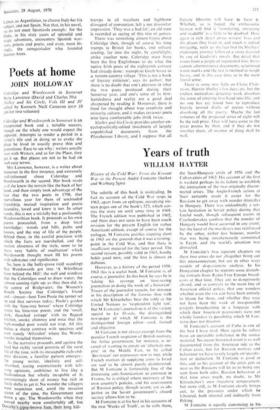Poets at home
JOHN HOLLOWAY
Coleridge and Wordsworth in Somerset Berta Lawrence (David and Charles 50s) Shelley and his Circle, Vols III and IV edited by Kenneth Neill Cameron (otm 10 ens for two volumes) Coleridge and Wordsworth in Somerset is an exceptional book and t. notable success,
though on the whole one would expect the opposite. Attempts to render a period in a writer's life and in doing so to evoke the place he lived in usually prove thin and pretentious. Easy to see why: writers usually start with Writers, and as for the Place, they get it up. But places are not to be had on such easy terms.
Mrs Lawrence, however, is a writer about Somerset in the first instance, and extremely well-informed about Coleridge and
Wordsworth in the second. Her book reads as if she knew the terrain like the back of her
hand, and then simply took advantage of the fact that the two poets in 1798, that marvellous year for them of unclouded friendship, mutual inspiration and poetic fecundity, loved and knew it too. In other words, this is not a trivially but a profoundly Wordsworthian book. It proceeds as his own poems proceeded, from a deep local knowledge: woods and hills, paths and houses, and the way of life of the people.
Behind these, in the careful precision with which the facts are marshalled, and the
modest closeness of the style, seem to lie those very 'habits of meditation' which Wordsworth thought must fill his poems k,ith substance and significance.
So, here is the holly-grove (still standing) that Wordsworth got into 'A Whirlblast from behind the Hill'; the well and windlass that the Coleridges used to draw water; the salmon coming right up, as they then did, to
the centre of Bridgwater; the Women's
Benefit Society that Coleridge's friend and—almost—host Tom Poole the tanner set Up and that survives today; Poole's garden with the lime-tree bower' where Coleridge Wrote his lime-tree poem; and the 'small, dark, thatched cottage' with its flagged kitchen, smoky chimney and mice that the high-minded poet would not trap. All this
makes a sharp contrast with spacious and even stately 'Alfoxden' where the Words- worths installed themselves.
As the narrative proceeds, and against the hard but richly varied patterns of the rural life of the time, with its inescapable rich-and- Poor division, a familiar pattern emerges:
the young writer, idealistic and self- absorbed, toying ostentatiously with left-
Wing opinions, ambitious to live like a
husbandman but wholly incapable of it, unremittingly short of money but rich in futile shifts to get it. No wonder the villagers were suspicious and, amid the invasion scares of the time, the Government sent
down a spy. The Wordsworths when they moved nearby were comfortably off, but rforothy's gipsy-brown face, their long hill-
tramps in all weathers and highbrow disregard of convention, left a not dissimilar impression. 'They was a bad lot', an old man is recorded as saying of this trio of genius.
There was something almost hippie about Coleridge then, though of course his long tramps to Bristol for books, and solitary reading, far into the night, by candlelight, strike another note. Coleridge must have been the first Englishman to do what the native Irish poets of the eighteenth century had already done: transplant Grub Street to a remote country village. 'This is not a book of literary criticism', says its author; but there is no doubt that one's pleasure in what the two poets produced during their Somerset year, and one's sense of its first- handedness and reality are a good deal sharpened by reading it. Moreover, there is food for thought about true creativity and minority culture, and it makes reviewer-poets who have comfortable jobs think twice.
Shelley and his Circle provides another en- cyclopaedically-edited instalment of largely
unpublished documents • from the Pforzheimer Library, and I suppose that all
literary libraries will have to have it. Whether, as is hoped, the enthusiastic layman will find it 'stimulating, intriguing and readable' is a little to be doubted. Here again is rich detail about writers' lives and the places they used in. and much is indeed intriguing, such as the fact that the Shelleys' elopement journey follossed a route dictated by one of Godwin's novels. But detail that issues from a jungle of regimental lists. Swiss canton administrative documents, scrutinised water-marks and the rest is inclined to sseigh hea y. and in this case does so in the most literal sense.
There is some new light on Claire Clair- mont, Harriet Shelley's last days. etc, but the endless meticulous detective work dissolves the sense of entering lirst-hand into life; and no one has yet found how to reproduce heavily revised drafts of poems without dissolving all the poetry. Maybe the last volumes of the projected series of eight will be the real prize. They will have come to the great poems by then, and if they do not smother them, all manlier of thing shall be well.






























 Previous page
Previous page